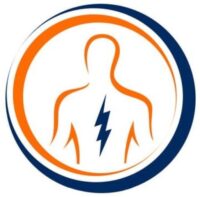A tailor’s bunion also called a bunionette, is a bony lump that forms along the side of the little toe, i.e., at the 5th metatarsal phalangeal joint. It is less common than a medial foot bunion.
Fundamentally, a tailor’s bunion is similar to the old regular type bunion, just on the other side of the foot.
Why they are named so?
Tailor’s bunion is named so as they commonly occur in tailors who sat cross-legged with the lateral aspect of their foot rubbing on the ground. Due to this rubbing, the head of the 5th metatarsal (the very bottom bone on the little toe), enlarges or shifts outwards.
But, then another question arises that is why do they occur in people who don’t sit like this for a longer period of time?
This is because there are also many other factors as well which can be a cause of tailor’s bunion apart from this position.
Let’s discuss the other causes of tailor’s bunion:
Causes of tailor’s bunion
The causes of this deformity can be broadly grouped into two:
- Structural causes
- Biomechanical causes
Structural Causes
Structural causes can include pressure over the lateral aspect of the 5th metatarsal head from tight shoes, static foot posturing (as in tailors), or a prominent lateral condyle.
Narrow shoes or high heels push the 5th toe towards the 4th toe as they provide less room for your toes. Over time, this can lead to bone/joint alignment changes, and joint irritation. and the bone enlargement.
Biomechanical Causes
Four biomechanical causes are:
- Abnormal pronation
- Uncompensated forefoot varus
- Congenital dorsiflexed 5th metatarsal
- Congenitally plantarflexed 5th metatarsal
1. Abnormal pronation
It is reported to be a factor in the cause of tailor’s bunion. Abnormal pronation causes hypermobility of the 5th metatarsal. This hypermobility produces internal shearing between the metatarsal and the overlying soft tissues.
2. Uncompensated forefoot varus
Uncompensated forefoot varus, exceeding the range of motion of pronation of the subtalar joint, causes the 5th metatarsal to bear excessive weight. This excessive weight-bearing forces the 5th metatarsal to dorsiflex and evert. This dorsiflexion and eversion cause the 5th metatarsal to abduct and the proximal phalanx of the 5th toe to adduct, resulting in a Tailor’s bunion.
3. Congenital plantar flexion of the 5th metatarsal
Congenital plantar flexion of the 5th metatarsal prevents the 5th metatarsal from dorsiflexing beyond the transverse plane of the other metatarsal heads. This plantarflexed and abnormal pronated foot causes the 5th metatarsal unstable. Ground reaction forces force the 5th metatarsal to evert, abduct, and dorsiflex. Eventually, the 5th metatarsal subluxated and is no longer functional.
4. Congenitally dorsiflexed 5th metatarsal
The last cause of a tailor’s bunion is a congenitally dorsiflexed 5th metatarsal. The only seen abnormality present is a bunion located dorsally. The dorsal attitude of the 5th toe causes abnormal shearing between the bone and the overlying dorsal soft tissues. This shearing is due to the firm fixation of the soft tissues because of the shoe.
Tailor’s bunion symptoms
Symptoms of this deformity include-
- Redness
- Swelling, &
- Pain, at the site of the enlargement
These symptoms occur when the shoe rubs against the enlargement, irritating the soft tissues and producing inflammation.
Tailor’s bunion diagnosis
They can be diagnosed easily by
- Prominence over the distal aspect of the 5th metatarsal head.
- Pain over the lateral or plantar aspect of the metatarsophalangeal joint, particularly with compressive shoewear.
- A tailor’s bunion X-ray can be helpful to determine the extent of the deformity.
There are three distinct types, based on the anatomic location of the deformity along the 5th metatarsal.
Type I deformity:
It demonstrates the presence of an enlarged 5th metatarsal head.
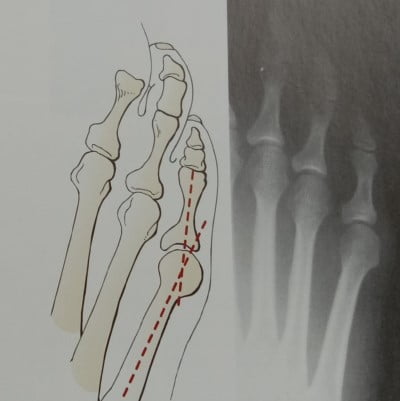
Type II deformity:
In this case, there will be lateral bowing of the 5th metatarsal diaphysis.

Type III deformity:
It demonstrates an abnormally widened fourth-fifth metatarsal angle (normal <8 degrees).
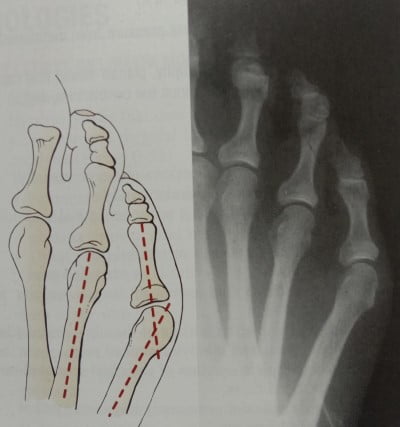
Management
- Switch to barefoot-style shoes with wide tow boxes.
- Use toe spreaders
- Spend lots of time barefoot whenever possible.
- Avoid sitting cross-legged and resting on the outside edge of the foot.
- Begin foot exercises
Treatment
Treatment for tailor’s bunion normally begins with non-surgical therapies.
- ICE PACKS: The application of ice 3-4 times a day helps to reduce inflammation and may also reduce pain.
- ELEVATION: Elevation of the feet may help to reduce swelling over the lateral aspect of the foot.
- NSAIDs: Some over-the-counter nonsteroidal anti-inflammatory drugs (NSAIDs) like ibuprofen may help reduce pain and swelling.
- SHOE MODIFICATIONS: Shoes with a wide toe box may help in relieving pressure over the bunion, and hence relieving pain.
- PADDING: Tailor’s bunion pads placed over the affected area may help in reducing symptoms. These silicone rings help to decrease the friction of each step and hence prevent the bunion from irritation.
- TOE SPREADERS: Wearing toe separators while sleeping may help to slow down the progression of the bunion.
- INJECTIONS: Corticosteroid injection may be helpful in treating the inflamed tissues around the joint.
- EXERCISES: (Will be discussed below)
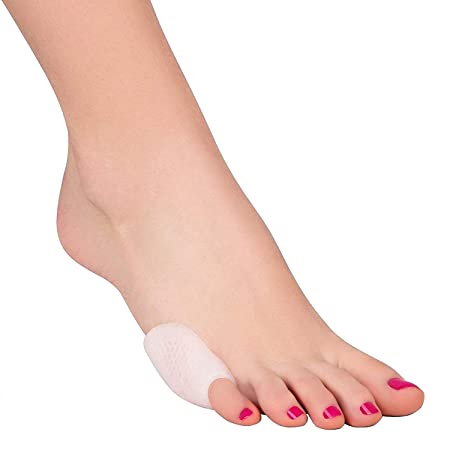
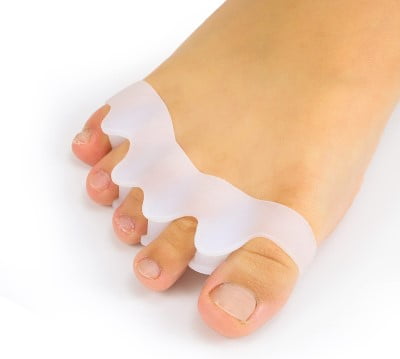
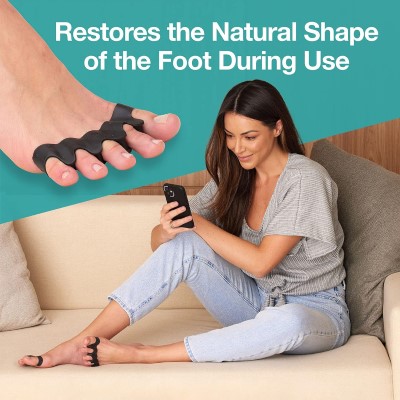
Surgical treatment is often considered when pain continues despite the above approaches. In selecting the procedure or surgery for your case, your surgeon has to consider x-ray investigations. The X-ray will help to determine the extent of your deformity. Based on the extent of the deformity, the surgical treatment will be implemented.
- Lateral metatarsal head condylectomy (TYPE I)
- Distal 5th metatarsal osteotomy (TYPE II)
- Oblique diaphyseal osteotomy (TYPE III)
Tailor’s bunion exercises
The little toe muscle called ‘abductor digiti minimi’ can help reduce the progression of the bunion. Exercising this muscle can help prevent this deformity and also help in treating this.
1. Toe Spread
2. Little Toe Lift
- Use a theraband to pull your toe out and up then press down.
- Do 3-5 lifts several times a day.
You can also use your finger instead of a band but they’re not as good as a band because they limit your range.
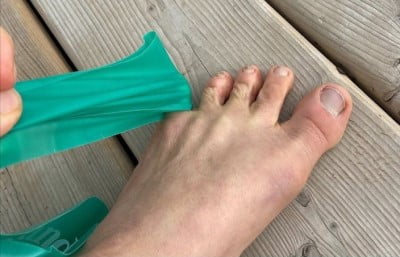
3. Towel Scrunch
- Place a towel on the ground.
- While sitting or standing, place your heel on the ground and rest ot the feet on the towel.
- Grasp the towel with your toes and crutch it towards your body.
- Heel should remain on the floor throughout the exercise.
- Repeat 5-10 times for each foot.
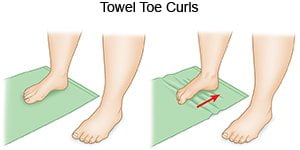
4. Marble Pick-up
- Spread the marbles out on the floor near the cup.
- Use your toes to pick up the marbles and put them in the cup.
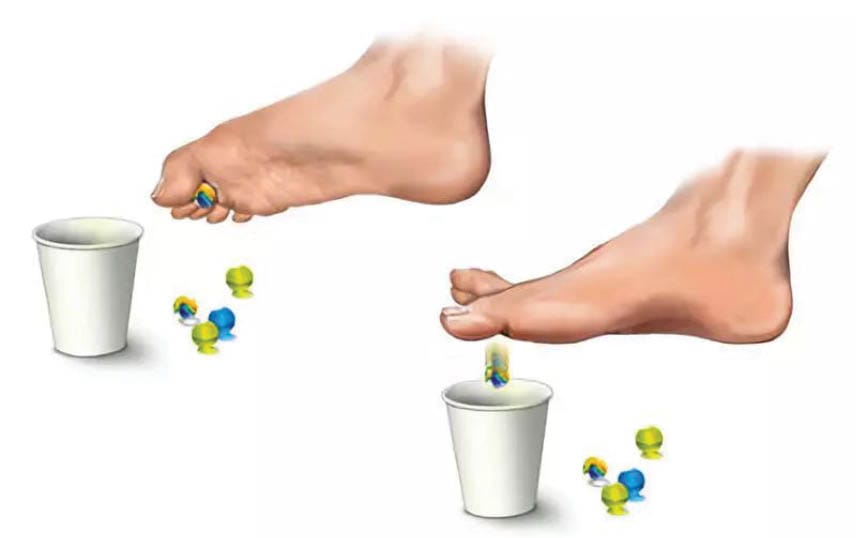
Conclusion:
Tailor’s bunion is a condition that affects the lateral aspect of the foot. It is called a tailor’s bunion as it is commonly caused in the cross-legged position which is a position that is usually acquired by tailors. Apart from this, there are also various other causes of it. Today, in this article we have discussed various management techniques and treatments for this deformity. We have also mentioned some exercises which may help you to get rid of them.
ALL THE BEST!
